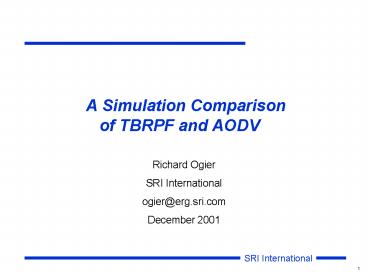A Simulation Comparison of TBRPF and AODV - PowerPoint PPT Presentation
1 / 18
Title:
A Simulation Comparison of TBRPF and AODV
Description:
AODV - CMU Monarch extensions, 12/07/2000. With link-layer failure ... ns-2 with CMU Monarch extensions. WaveLAN IEEE 802.11 MAC with rate 2Mb/s and range 250m ... – PowerPoint PPT presentation
Number of Views:37
Avg rating:3.0/5.0
Title: A Simulation Comparison of TBRPF and AODV
1
A Simulation Comparison
of TBRPF and AODV
- Richard Ogier
- SRI International
- ogier_at_erg.sri.com
- December 2001
2
Protocols Simulated
- AODV - CMU Monarch extensions, 12/07/2000.
- With link-layer failure detection
- Without local repair
- TBRPF - version 04 (current). Same code used for
implementation was interfaced to ns-2 using our
API. - With link-layer failure detection.
- Packets with no route are buffered for up to 5
seconds. - ARP was not used, since MAC addresses can be
obtained from received routing packets.
3
Simulation Model
- ns-2 with CMU Monarch extensions
- WaveLAN IEEE 802.11 MAC with rate 2Mb/s and range
250m - 50 and 100 nodes
- Two area sizes 670m x 670m and 1500m x 300m
- Mobility model No mobility and random waypoint
model with 0 pause time and maximum speed 20 m/s. - 20 and 40 CBR sources each source changed its
destination randomly every 30 s. - The following measures were plotted for
increasing packet generation rates - percent of packets delivered
- average end-to-end delay
- routing load in kbytes, including IP/MAC headers.
- path length (average hops, or ratio to optimal
when available)
4
Simulation comparison of TBRPF and AODV50
nodes, 20 sources, 670x670 area, no mobility
DELAY
congested
PERCENT DELIVERED
PATH LENGTH
ROUTING LOAD
5
Simulation comparison of TBRPF and AODV50
nodes, 20 sources, 670x670 area, max speed 20mps
DELAY
congested
PERCENT DELIVERED
PATH LENGTH
ROUTING LOAD
6
Simulation comparison of TBRPF and AODV50
nodes, 20 sources, 1500x300 area, no mobility
DELAY
PERCENT DELIVERED
PATH LENGTH
ROUTING LOAD
7
Simulation comparison of TBRPF and AODV50
nodes, 20 sources, 1500x300 area, max speed 20mps
DELAY
congested
PERCENT DELIVERED
PATH LENGTH
ROUTING LOAD
8
Simulation comparison of TBRPF and AODV100
nodes, 20 sources, 670x670 area, no mobility
DELAY
PERCENT DELIVERED
ROUTING LOAD
PATH LENGTH
9
Simulation comparison of TBRPF and AODV100
nodes, 20 sources, 670x670 area, max speed 20mps
DELAY
PERCENT DELIVERED
ROUTING LOAD
PATH LENGTH
10
Simulation comparison of TBRPF and AODV100
nodes, 20 sources, 1500x300 area, no mobility
DELAY
PERCENT DELIVERED
ROUTING LOAD
PATH LENGTH
11
Simulation comparison of TBRPF and AODV100
nodes, 20 sources, 1500x300 area, max speed 20mps
DELAY
PERCENT DELIVERED
ROUTING LOAD
PATH LENGTH
12
Simulation comparison of TBRPF and AODV50
nodes, 40 sources, 670x670 area, no mobility
DELAY
PERCENT DELIVERED
ROUTING LOAD
PATH LENGTH
13
Simulation comparison of TBRPF and AODV50
nodes, 40 sources, 670x670 area, max speed 20mps
DELAY
PERCENT DELIVERED
PATH LENGTH
ROUTING LOAD
14
Simulation comparison of TBRPF and AODV50
nodes, 40 sources, 1500x300 area, no mobility
DELAY
PERCENT DELIVERED
PATH LENGTH
ROUTING LOAD
15
Simulation comparison of TBRPF and AODV50
nodes, 40 sources, 1500x300 area, max speed 20mps
DELAY
PERCENT DELIVERED
PATH LENGTH
ROUTING LOAD
16
Simulation comparison of TBRPF and AODV100
nodes, 40 sources, 670x670 area, max speed 20mps
DELAY
PERCENT DELIVERED
Delay for AODV is based on fewer packets.
ROUTING LOAD
PATH LENGTH
17
Simulation comparison of TBRPF and AODV100
nodes, 40 sources, 1500x300 area, max speed 20mps
DELAY
PERCENT DELIVERED
ROUTING LOAD
PATH LENGTH
18
Summary of simulation results
- TBRPF consistently achieved close to 100
delivery fraction when the network was not
congested. - With 20 sources, TBRPF and AODV had similar
performance, but TBRPF had a significantly (4-6)
higher delivery fraction for the 1500x300 area
with mobility,and AODV has significantly lower
delay when congestion occurred. - With 40 sources, TBRPF consistently outperformed
AODV, and had a significantly (about 10) higher
delivery fraction for the 1500x300 area for 100
nodes. - TBRPF consistently used the shortest paths,
typically 10-15 shorter than for AODV.































